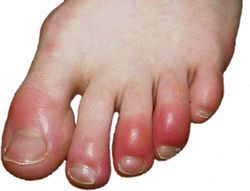Chilblains…And How To Avoid Them This Winter

What are chilblains?
Chilblains, also known as pernio or perniosis, are small swellings that develop on the skin. They can be red or in some cases purple or blue in colour. They develop on the body’s extremities, most commonly on the toes, heels and other areas of the feet. People can also develop chilblains on their fingers, ears and nose. Chilblains are usually painful, itchy and tender to touch. In severe cases, the surface of the skin may break and sores or blisters can develop.
What causes chilblains?
When the skin is cold, blood vessels constrict and when the skin is exposed to heat, blood vessels dilate and become wider. When this constriction and dilation of blood vessels occurs too quickly, damage to the vessels can occur and fluid can leak into the surrounding tissue causing inflammation and consequently a chilblain. Chilblains usually appear within a few hours of exposure to the cold and symptoms can last 1-2 weeks.
Who is likely to get chilblains?
- Chilblains are more common in the elderly and children, but can occur at any age.
- Women are more commonly affected than men.
- People who have poor circulation or who have a condition that affects their circulation such as diabetes, vasculitis or Raynaud’s disease.
- Smokers.
- Underweight patients.
- Those who have a family history of chilblains.
- People who are on certain medications that cause blood vessels to constrict, such as beta blockers.
How can I avoid Chilblains?
- Avoid or limit exposure to the cold by dressing in warm layered clothing, including gloves and thick socks.
- Try to keep your skin warm consistently.
- If your skin is exposed to the cold, try to warm up gradually through clothing rather than immediately with for example a hot water bottle.
- Paraffin wax foot baths at your podiatry clinic can assist in stimulating foot circulation to reduce your risk of chilblains.
- Stay active to improve your circulation.
- Stop smoking.
- Have your medications checked by your GP.
What should I do if I get a Chilblain?
- Avoid scratching the skin.Applying corticosteroid creams can help to ease itching and inflammation.
- Antiseptic creams can be applied to prevent infection of broken skin.
- In severe cases of chilblains where the skin has broken and formed a sore, seek medical attention from your podiatrist.
- If chilblains are recurring, your GP may be able to prescribe a medication that assists in dilating the small blood vessels.
If you have concerns about developing chilblains this winter, seek expert advice from one of our Melbourne podiatrists. At Camberwell Road Podiatry, all of our Melbourne podiatrists are trained professionally to help you minimise your risk of developing chilblains through expert advice and treatments including paraffin wax foot baths.

Do Your Feet Need Podiatry Care?
If you have concerns about developing chilblains this winter and would like to see one of our Melbourne podiatrists, book a consultation online or by calling +61 3 9882 5584


